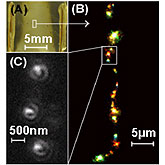More Physics Facts
Atmospheric :
- Coming In Strong On Your AM Dial
- Does Earth Have Its Own Neon Sign?
- Somewhere Over Which Rainbow?
- Sonic Boom
- The Coriolis Effect
- The Doppler Effect
- The Sound of Turbulence
- Your Own Personal Rainbow?
Classical Mechanics:
- Can You Miss the Earth?
- Don't Make Waves
- What Makes a Frisbee Fly?
- Why Does A Golf Ball Have Dimples?
- Your Serve
Electricity:
Fundamentals:
- Bizarre Boiling
- Galileo Thermometers
- Get the Point?
- How Fast is Mach 1?
- How Lasers Work
- Kinetic Theory of Gases
- Many Happy Returns!
- Newton's First Law of Motion
- Newton's Three Laws of Motion
- The Fourth State of Matter
- The Physics of Sandcastles
- The Weakest Force
- Tick-Tock Atomic Clock
- Torque
- What Is An Atom?
- What Is Radiofrequency Energy (Rf)?
- X-Rays - Another Form of Light
Magnetism:
Nonlinear Dynamics & Chaos:
Optics:
- Delivered by TIR
- Does Your Brain Do Flips?
- Quick Change Artist
- Single Molecule Electroluminescence
- Ultraviolet Light
Quantum Mechanics:
- Antimatter Discovery
- Neutrinos to the Rescue
- Quarks
- The Early Universe Soup
- The Equivalence Principle
- The World's Largest Laser
Radioactivity:
- Carbon Dating From The Skies
- Fission and Fusion
- Nuclides & Isotopes
- When Do We Encounter Ionizing Radiation In Our Daily Lives?






